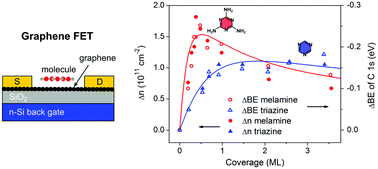Graphene field effect transistor as a probe of electronic structure and charge transfer at organic molecule–graphene interfaces†
Abstract
The electronic structure of physisorbed molecules containing aromatic nitrogen heterocycles (triazine and melamine) on graphene is studied using a combination of electronic transport, X-ray photoemission spectroscopy and density functional theory calculations. The interfacial electronic structure and charge transfer of weakly coupled molecules on graphene is found to be governed by work function differences, molecular dipole moments and polarization effects. We demonstrate that molecular depolarization plays a significant role in these charge transfer mechanisms even at submonolayer coverage, particularly for molecules which possess strong dipoles. Electronic transport measurements show a reduction of graphene conductivity and charge carrier mobility upon the adsorption of the physisorbed molecules. This effect is attributed to the formation of additional electron scattering sites in graphene by the molecules and local molecular electric fields. Our results show that adsorbed molecules containing polar functional groups on graphene exhibit different coverage behaviour to nonpolar molecules. These effects open up a range of new opportunities for recognition of different molecules on graphene-based sensor devices.


 Please wait while we load your content...
Please wait while we load your content...